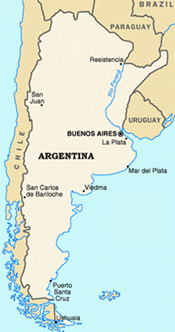|
Official Name: The Argentine Republic
GEOGRAPHY
Area: 2.8 million sq. km (1.1 million sq. mi.); about the size of the U.S. east
of the Mississippi River; second largest country in South America.
Cities: Capital--Buenos Aires (city: 3 million; metropolitan area: 12 million).
Other major cities: Cordoba (1.2 million); Rosario (950,000); Mar del Plata
(900,000); Mendoza (400,000)
Terrain: Andes mountains and foothills in west. Aconcagua, (7,021 m; 23,034 ft)
is highest peak in the Western Hemisphere; remainder of country is lowland;
central
region characterized by vast grassy plains (pampas).
Climate: Varied: predominantly temperate with extremes ranging from subtropical
in the north to arid/subantarctic in far south.
PEOPLE
Nationality: Noun and adjective--Argentine(s).
Population (mid-1995): 34.6 million.
Annual population growth rate: 1.3%.
Ethnic groups: European 97% , mostly of Spanish and Italian descent.
Religions: Roman Catholic 92% , Protestant 2% , Jewish 2% , other 4%.
Language: Spanish.
Education: Years compulsory--7; Adult literacy--96.2%.
Health: Infant mortality rate--23.6/1000. Life expectancy of newborns: 72.3
years.
Work Force: Industry and commerce--36% , agriculture--19% , transport and
communications--6%.
GOVERNMENT
Type: Republic.
Independence: July 9, 1816.
Constitution: 1853, revised 1994.
Branches: Executive--president, vice president, cabinet.
Legislative--bicameral congress (72-member Senate, 257-member Chamber of
Deputies).
Judicial--Supreme Court, federal and provincial trial courts.
Administrative subdivisions: 23 provinces and one federal capital district.
Political Parties: Justicialist, Radical Civic Union, FREPASO, numerous smaller
national and provincial parties.
Suffrage: universal adult.
ECONOMY (1997 projections)
GDP: $292 billion.
Annual real growth rate: 5% .
Per capital GDP: $8,500.
Natural resources: Fertile plains (pampas). Minerals: lead, zinc, tin, copper,
iron, manganese, oil, uranium.
Agriculture (7% of GDP, about 60% of exports by value) Products--grains,
oilseeds and by-products, livestock products.
Industry (26% of GDP), Types--food processing, oil refining, machinery and
equipment, textiles, chemicals and petrochemicals.
Trade: Exports--$24.5 billion: grains, meats, oilseeds, manufactured products;
Major markets--Brazil 25% ; U.S. 11% ; EU 25% .Imports--$25.5 billion:
machinery, vehicles and transport products, chemicals. Major suppliers--U.S.
23% , Brazil 20% , EU 28% .
U.S.-ARGENTINE RELATIONS
The United States and Argentina currently enjoy a close bilateral relationship,
although this has not always been the case. The efforts of the Menem
Administration to open Argentina's economy and realign its foreign policy have
contributed to the improvement in these relations, and the interests and
policies of the two countries coincide on many issues. Argentina and the United
States often vote together in the United Nations and other multilateral fora.
Argentina has participated in many multilateral force deployments mandated by
the United Nations Security Council, including recent missions to Haiti and the
former Yugoslavia. Reflecting the growing
partnership that marks ties between the two countries, on December 5, 1996,
President Clinton and Argentine President Menem announced the establishment of
a special consultative process to address important issues in the bilateral
relationship.
ADDITIONAL INFORMATION
For more information, visit the
State Department's home page.
|

